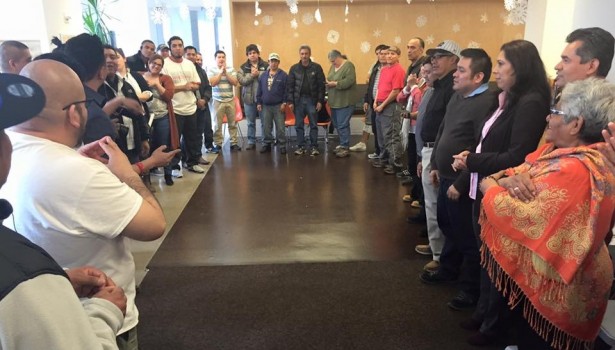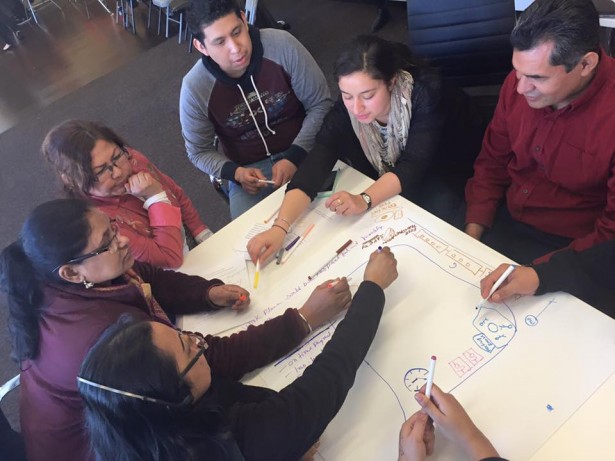
Omar Trinidad, pulls off a mask, as he speaks to a room of restaurant, retail, day labor, street vendor and domestic workers from across New York City. “Being a day-laborer does not make me invisible, it makes me indispensable. Being a street vendor does not make anyone less worthy, it makes us unstoppable. To build a movement, let’s take off the mask of fear! Basta ya.”
For Trinidad, a member-leader at New Immigrant Community Empowerment, or NICE, ending exploitation of day laborers is not enough. He understands that a movement requires the power of all the immigrant workers who have built, and continue to build this city — which is why for the last 12 months Trinidad has joined over 30 workers from across the city to take part in the New York Worker Center Federation’s Delfino Leadership Institute.
The institute is the nation’s first independent worker center leadership program led by and for immigrant workers, named in honor of Delfino Velasquez, a day laborer and member of the federation who was killed in a work-related accident on Staten Island in 2014.
March 12 saw the culmination of Trinidad’s experience with the Delfino Leadership Institute as he took on the role of the trainer, addressing a group of over 50 workers during the Delfino Teach-back. After spending the year learning and growing as a movement builder, it was now Trinidad’s turn to share and transfer his power with the hopes of inspiring the next cohort of leaders.
Education is power
While leadership development programs are not new, Delfino uses a model of coeducation to build a united front of new leaders across sectors, cultures, communities, languages, nationalities and organizations. As workers come together they not only develop skills and strategies, but are actively building a new workers movement.
“We, the workers and organizers, modeled this program after similar activist training programs in nonviolent movements around the world,” explained Daniel Carrillo, director of Enlace. “The communities in Burma or the Zapatistas know that powerful movements can only come from unified strategy, when local leaders from across different spaces build together.” The institute recognizes the isolation which often prevents immigrant workers from collectively organizing limits the strategy they can take to the streets. “We’ve seen how groups like the Food Chain Workers Alliance connect processors and pickers to build a more sustainable food system,” Carrillo said, “so we recognize that the entire sector of immigrant workers in New York connecting their issues and strategies will generate a stronger movement for alternative worker power.”
The Delfino Leadership Institute unites workers through bi-monthly trainings on movement building, organizing and base building, campaign strategizing, facilitation, and political education. Building on workers center’s strong global focus and ethnic and racial identifications, worker leaders in the institute are taking age-old strategies of nonviolent resistance and remaking them with their own cultural symbols, languages and industry-related contexts.
Between workshops, participants’ consciousness and skills are put to work leading their own committees, fighting challenging boss campaigns, and developing synergistic strategies. Following a training on anti-blackness within the workers justice movements, Delfino participants organized a joint action on the Night Out for Safety and Liberation, to demonstrate to the police that there could not be a safe night with immigrants and communities of color facing continued harassment.
The liberatory education pedagogy built off the Southern Freedom Schools and the Latin American social movements seeks to transform workers from the inside out with the aim of generating new analysis and tactics of how immigrant workers play a role in broader struggles for justice. With each session, workers are able to make connections and build genuine grassroots solidarity and at the final session, the graduating workers take the reins and become the trainers to a new cohort of workers. They continue to serve on the steering committee, mentoring new workers and building connections across spaces.
A federation
The Delfino Leadership Institute was born out of the New York Worker Center Federation, which formed in October 2014 when workers in a training voted to create a space where they could continue to build and organize together. Organizations included: NICE, the Laundry Workers Center, Desis Rising Up and Moving, El Centro del Inmigrante, Cidadao Global, the Street Vendor Project at the Urban Justice Center, and Enlace. The federation is actively expanding and this year will move to accept additional worker centers at member organization.

“In order for workers centers to be truly transformative,” said Jorge Torres, organizer of El Centro del Inmigrante, “there is a need to come together in federations and training programs, like labor unions have done for decades, to share knowledge and resources, support one another’s campaigns, build a united movement of the workers we organize, and increase the visibility of the approaches to economic and social justice work.”
In the face of ongoing attacks on labor, the federation aims to reclaim the power old-labor once held, but in a new way. “We can even inspire and reinvigorate the mainstream labor movement, which has been struggling to retain its power and relevance as the economy and workforce changes around it,” Torres added.
The possibility for workers centers to redefine the labor movement has long been documented by Janet Fine and other key researchers, but could be witnessed clearly in an exercise on March 12. “The unique aspect of the workers center movement,” said Christina Fox, the worker center coordinator at NICE, “is that we’re creating alternatives while we are dismantling structures of power. It’s the rehearsal for the revolution and the battle itself.”
To illustrate, workers were instructed to design their ideal work places and begin to imagine the conditions and methods of production, inspired by the factory takeovers by workers in Argentina. Then, facilitators, acting like bosses, came around and tried to sabotage and undermine their visions by trying to create tensions among workers, deny rights, or even destroy the ideal workplaces. The room erupted into a full blown strike, as groups who had already had their workplaces taken, locked arms with those who they could save, “strike, strike, huelga, huelga,” the crowd roared.
“These dynamics play out in real life,” said Fox, as the activity began. “We’re literally developing a democratic workplace where all workers know their rights, and some of us develop cooperatives, while we’re also fighting the bosses on the streets.”
Story of a movement
According to Elise Goldin an organizer at the Street Vendor Project, the New York Worker Center Federation draws parallels from movements like Black Lives Matter, which works against the mythology of the dispensability of black lives. “At the corner of this work has to lie the principle that immigrant workers are not dispensable,” she explained. “In order to organize together, we need to tell a new story together.”
Heleadora Vivar, a 72-year-old street vendor and leadership board member at the Street Vendor Project, has spent more than 15 years battling against worker injustice.
While the exploitation street vendors endure may take a different shape from that felt by restaurant workers, Vivar, a mother of seven, recognizes that it is all part of the same oppressive system. “I know that we all suffer the same pains as street vendors and as cab drivers, but we must be able to share these, to connect these struggles,” she said. “We will not let the next generation suffer as we have.”
Like Black Lives Matter, the movement also seeks to center healing justice, to create spaces where the experiences of exploitation are deeply felt, connected and released. The federation believes this is the heart of transformative leadership and sustainable movements.
“In Delfino, participants love, support, affirm and hold each other accountable,” said Rosanna Rodriguez, co-director of the Laundry Workers Center. “They set their own leadership goals and process their own traumatic experiences, because that will truly build the kind of leaders our movements needs.”
